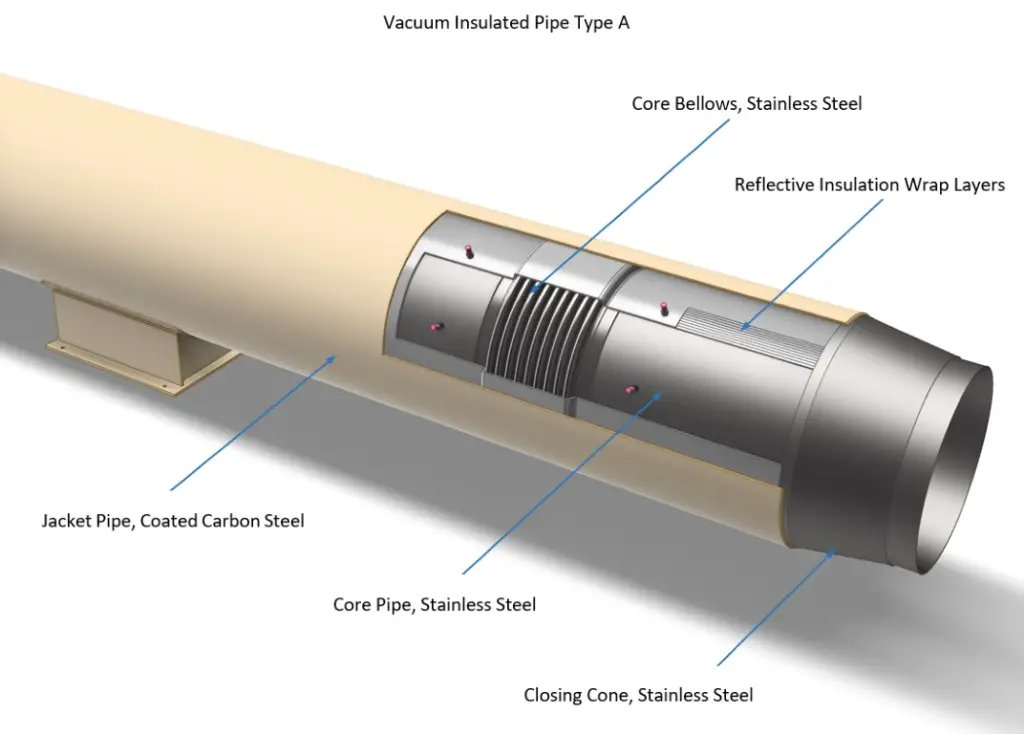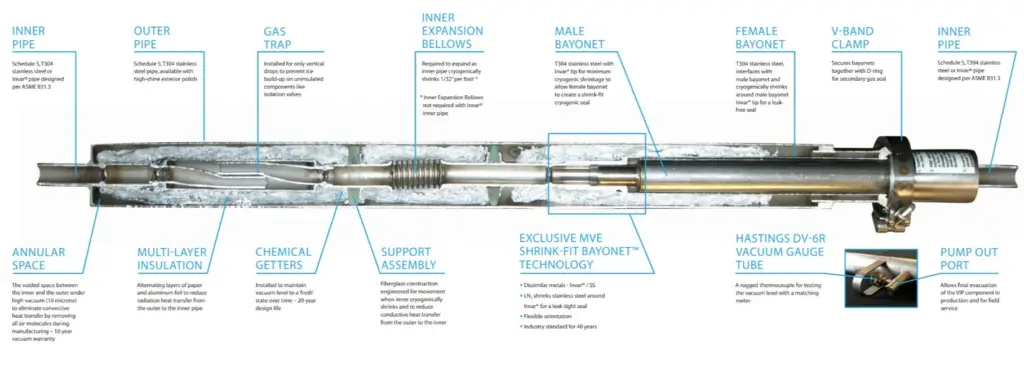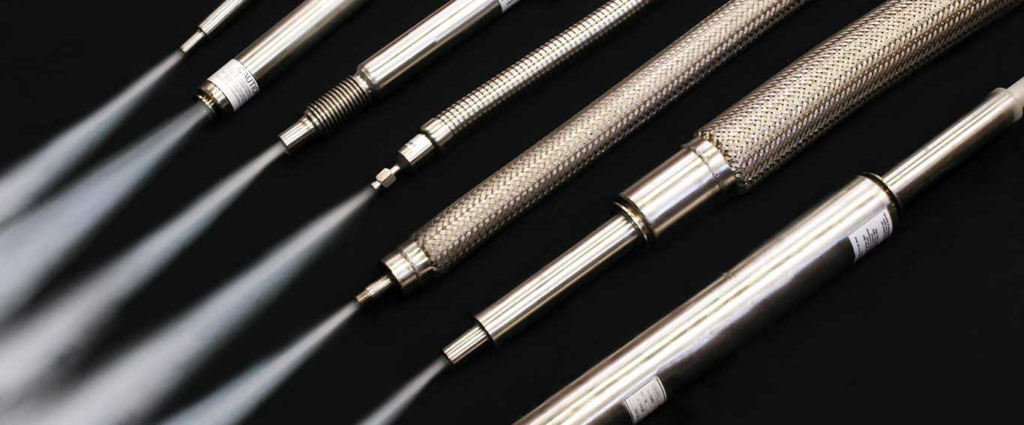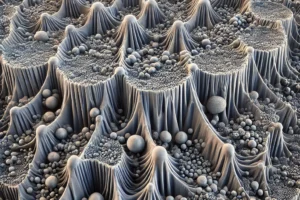Vacuum insulated piping (VIP), also known as vacuum jacketed piping, is a specialized cryogenic piping system designed for the transportation of cryogenic liquids such as LNG, liquid nitrogen, or liquid oxygen. This system consists of two concentric pipes- a central inner pipe for carrying the cryogenic liquid and an outer pipe acting as a vacuum jacket.
The space between the inner and outer pipes is evacuated to create a vacuum environment. This vacuum serves as a highly effective thermal insulation barrier, minimizing heat transfer through convection and conduction. The vacuum jacket is typically constructed from stainless steel and features an outer protective layer made of materials like polyethylene.
VIP systems are specifically engineered to maintain a high vacuum level over long distances, ensuring the preservation of the cryogenic liquid’s temperature during transportation. The inner pipe is carefully selected based on compatibility with the specific cryogenic liquid being transported, commonly utilizing materials like stainless steel or copper. These piping systems find extensive applications in industries such as LNG terminals and industrial gas supply systems that necessitate the efficient and reliable transport of cryogenic liquids over significant distances. Vacuum jacketed pipes are manufactured in various sizes, typically ranging from 1/2 inches to 16 inches, to accommodate diverse operational requirements.
Applications of Vacuum Insulated Piping System
Applications of vacuum-insulated piping systems are diverse, catering to the transportation needs of cryogenic liquids. Let’s explore some common applications for these systems.
Liquefied Natural Gas (LNG) Terminals: Vacuum-insulated piping is instrumental in transferring LNG from storage tanks to ships, railcars, or trucks at LNG terminals. Its superior insulation properties minimize heat transfer and reduce LNG evaporation.

Industrial Gas Supply Systems: Vacuum-insulated piping efficiently transports cryogenic gases like nitrogen, oxygen, and argon from production facilities to customer sites. Maintaining the gases at the required temperature and pressure ensures safe and efficient industrial processes.
Food and Beverage Industry: Vacuum jacketed piping plays a vital role in transporting cryogenic liquids like liquid nitrogen and carbon dioxide for cooling, freezing food products, and carbonating beverages.
Medical and Pharmaceutical Industry: Vacuum-insulated piping is employed to transport cryogenic liquids for medical and pharmaceutical applications, including cryo-preservation using liquid nitrogen and respiratory therapy utilizing liquid oxygen.
Aerospace Industry: Vacuum-insulated piping is crucial for transporting cryogenic propellants used in rockets and spacecraft. Its exceptional insulation properties guarantee the desired temperature and pressure levels during transport.
By employing vacuum-insulated piping systems, various industries can ensure the reliable, efficient, and safe transportation of cryogenic liquids for their specific applications.
The Various Advantages
Vacuum insulated piping (VIP) offers numerous advantages over traditional insulated piping systems, providing a range of benefits for cryogenic liquid transportation. Here are some key advantages of VIP:
Superior thermal insulation: This piping system excels in thermal insulation, minimizing heat transfer through conduction and convection. This enables long-distance transportation of cryogenic liquids with minimal evaporation loss.
Cost-effectiveness: VIP can be more cost-effective than conventional insulated piping systems due to its reduced insulation material requirement, resulting in overall cost savings for the system.
Lower maintenance requirements: It demands less maintenance as it is designed to maintain a high vacuum level over extended periods. This reduces the need for frequent inspections and repairs.
Enhanced safety: This system reduces the risk of accidents and spills by minimizing cryogenic liquid loss through evaporation, thereby enhancing overall safety during transportation.
Flexible design options: Vacuum Insulated Piping can be tailored to meet specific project requirements, including transport distance, flow rate, and pressure. It can be customized for different cryogenic liquids and adapted to operate under varying environmental conditions.
Reduced environmental impact: VIP contributes to a reduced environmental footprint by curbing cryogenic liquid loss through evaporation. This mitigates greenhouse gas emissions and environmental concerns associated with liquid loss during transportation.
By leveraging these advantages of VIP, industries can achieve efficient and cost-effective transportation of cryogenic liquids while prioritizing safety and environmental sustainability.
Types of Vacuum Insulated Pipes
Based on their structure and design, vacuum insulated pipes (VIP) can be divided into two categories:
Flexible vacuum insulated pipes (FVIP):
Flexible vacuum insulated pipes (FVIP) are made up of an inner pipe for transporting cryogenic liquid and an outer vacuum jacket made of a flexible material, such as polyethylene. The elasticity of the outer jacket helps to maintain the vacuum between the inner and outside pipes. For applications that need flexibility and simple installation, such as the transit of LNG (Liquefied Natural Gas) between ports or in distribution networks, FVIP is appropriate.
Rigid Vacuum Insulated Pipes (RVIP):
RVIPs are made up of an outer vacuum jacket made of a rigid material, such as stainless steel, and an inner pipe for carrying the cryogenic liquid. The stiffness of the outer jacket maintains the vacuum space between the inner and outer pipes. Applications requiring high thermal efficiency and long-distance transportation, including industrial gas supply systems or the aerospace sector, are suited for RVIPs.
Vacuum insulated piping, thus, come in two different varieties, each with their own benefits and drawbacks. The decision between FVIP and RVIP depends on the particular application needs.

Specifications of Vacuum Insulated Piping System
The specifications of vacuum insulated pipes (VIP) vary based on factors like the cryogenic fluid being transported, temperature range, pressure, flow rate, and distance of transportation. Here are some common specifications:
Inner Pipe: Made of corrosion-resistant materials like stainless steel, the diameter of the inner pipes range from a few inches to several feet, depending on their application. It is designed to withstand low temperatures and high pressures of the cryogenic fluid.
Outer Jacket: The outer jacket, typically constructed from materials such as polyethylene or stainless steel, creates a vacuum space between the inner and outer pipes. This vacuum space provides excellent thermal insulation, minimizing heat transfer.
Insulation: Multiple layers of materials like fiberglass, perlite, or aerogel form the insulation layer. It enhances thermal insulation, further reducing heat transfer.
Fittings and Valves: VIP requires specialized fittings and valves designed to maintain the vacuum level and withstand the cryogenic fluid’s low temperature and high pressure.
Vacuum Level: VIP systems need a minimum vacuum level of 10-5 torr to ensure efficient thermal insulation.
Testing: VIP undergoes rigorous testing to ensure it meets design specifications. This includes evaluating the vacuum level, insulation efficiency, and pressure resistance.
Standards: VIP must comply with industry standards such as ASME B31.3, which outlines requirements for piping systems transporting cryogenic fluids.
Proper specification of VIP ensures safe and efficient transportation of cryogenic fluids over long distances, with minimal heat loss and high thermal efficiency.

Comparing Vacuum Insulated Piping to Traditional Cryogenic Fluid Transfer Piping: Key Differences
Vacuum Insulated Piping (VIP) and traditional cryogenic fluid transfer piping have several key differences.
- Insulation: VIP utilizes a vacuum space between inner and outer pipes for superior thermal insulation, whereas traditional piping relies on foam or fiberglass insulation. This vacuum insulation in VIP can decrease heat transfer by conduction and convection by up to 90%, making it highly efficient.
- Heat loss: Another distinction is in heat loss during fluid transportation. Vacuum Jacketed Pipes, like VIP, minimize heat loss, while traditional piping tends to lose a significant amount of cryogenic fluid through evaporation.
- Maintenance: Maintenance requirements also differ. VIP necessitates less maintenance as it is designed to maintain a high vacuum level over extended periods. Conversely, traditional piping requires regular maintenance to uphold effective insulation.
- Cost: In terms of cost, VIP may be initially more expensive due to specialized materials and manufacturing processes needed to maintain a high vacuum level. However, reduced heat loss and maintenance costs make VIP more cost-effective in the long run.
- Flexibility: Flexibility is another aspect where VIP excels. It can be designed to accommodate various cryogenic fluids and operate in diverse environmental conditions. On the other hand, traditional piping is generally less flexible and may not be suitable for certain applications.

To summarize, VIP offers superior thermal efficiency, reduced heat loss, and lower maintenance requirements compared to traditional cryogenic fluid transfer piping. While VIP may have higher upfront costs, it proves to be more cost-effective in the long term due to reduced maintenance and improved safety.
Manufacturers of Vacuum Insulated Pipes
Vacuum-insulated pipes (VIP) are produced by a number of well-known companies worldwide. Among the well-known ones are:
- Chart Industries is a well-known producer of VIP systems and other cryogenic equipment. For uses including LNG and industrial gases, Chart Industries offers a range of VIP systems.
- Based in the US, Cryofab specialises in manufacturing cryogenic equipment, such as VIP systems. They offer VIP systems for LNG, industrial gases, and medicinal gases.
- The French firm Cryostar develops and produces cryogenic apparatus, such as VIP systems. They provide a selection of VIP systems appropriate for uses including LNG and industrial gases.
- Technifab Products, Inc. is a US-based manufacturer that specialises in cryogenic equipment, such as VIP systems. Applications including LNG, industrial gases, and liquid are catered for by their VIP systems.
- VIP systems are also produced by Cryogenic Industries, a manufacturer of cryogenic equipment on a global scale. For a variety of uses, including LNG, industrial gases, and liquid nitrogen, they provide VIP systems.
- German business Kryo-Tech is an expert in cryogenic equipment, which includes VIP systems. They offer VIP systems for applications including LNG, industrial gases, and liquid nitrogen.
These are just a handful of credible producers of VIP systems. It’s crucial to pick a supplier who has a solid track record of providing high-quality VIP systems that meet your unique specifications.











